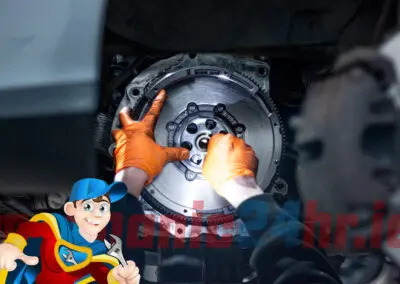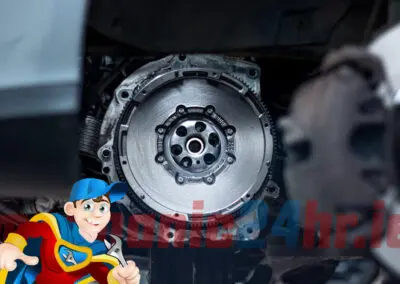Nevertheless, clutch replacement is necessary after every 40,000km to 100,000km or more, depending on various factors.
Manual Clutch Problems and What Causes Them
Certain driver behaviors such as riding the clutch pedal and letting it slip excessively quicken the wear and tear process. But those are not the only causes.
Accelerated clutch wear also comes from the increased load. This includes heavy loads in your van or towing a heavy trailer. If you’ve modified the engine to boost power, that will also increase the demand on the clutch.
Typically, the clutch is rated to handle a particular amount of force at a time. This rating depends on a handful of factors such as the expected use, type of driving, and the engine’s power output. You will find higher capacity clutches in performance and heavier vehicles to handle the extra demands.
In such a case, the pressure plate and the clutch disc will have friction and wear-resistant lining material to reduce the increased demand. It will also most likely have a larger diameter to spread the load across a wider area. The other characteristics of a heavy-duty clutch include stiffer coil springs or diaphragm springs to accommodate higher demands without slipping.
Clutch Replacement the Right Way
The process may include replacing the transmission input shaft seal, a rear main crankshaft seal, or even an intake manifold gasket set. If it’s necessary to replace the oil-contaminated clutch disc on a vehicle with less than 40,000 miles, you can reuse the release bearing and original pressure plate. The caveat, however, is that they must be in good condition.
But if the clutch failure was on the release bearing, pressure plate, and a clutch disc of a high-performance vehicle, it’s recommended to replace all three simultaneously. Clutch replacement is labor-intensive, and replacing everything in one fell swoop takes care of the problem once and for all. You will not have to complain about the same problem.
A clutch kit includes a new pressure plate, clutch disc, and release bearing. Sometimes going the clutch kit way is better because all the parts are from the same brand. They are matched and are the best fit for each other.
The condition of the flywheel is critical. It must be flat, smooth, and clean to support the effective functioning of the clutch. It should also be free of cracks or other blemishes. Otherwise, replacement or resurfacing may be necessary.
Other Causes of Clutch Slips and Vibrations
Apart from oil leakage, there are various other causes for clutch slips. Worn clutch facings, fouling of the pedal or partial seizure of the linkage defective pressure plate, partially seized mechanism, and broken springs will all cause the clutch to slip.
A severe low-frequency vibration will tell you that all is not well with the clutch. There are various causes for these vibrations. Misalignment of the gearbox to the engine, worn or loose engine mountings, oil contaminated facings, and the clutch arm’s uneven operation can all conspire to cause vibrations.
The other reasons for the vibrations include the worn spigot bearing and glazed or scored flywheel.
What About Clutch Release Problems?
Clutch problems for older vehicles may be from the cable release mechanism. Misadjusted or broken cable or even problems with the pivot fork will prevent the clutch from releasing.
What Does the Clutch Noise Mean?
But the sudden jolt of the vehicle even when you are gently releasing the pedal indicates a misalignment between the gearbox and the engine, oil-contaminated driven plate, or worn hydraulic system. An uneven clutch arm operation can also be the culprit for the uncomfortable jolt.
The clutch noise in your vehicle can also be because the facings are oil-contaminated, or particular parts such as the buckled plate, driven plate, and the spigot bearing are worn out.
On the other hand, the pilot bushing problem is only in vehicles with a pilot bushing on the crankshaft back end. This particular component may or may not be part of the clutch kit, depending on the application.
Clutch Check or Replacement
Sometimes, you are unsure whether your clutch is faulty or not, and it is okay. You can come over at Mechanic24hr for a complete clutch check while you wait. Our expert diagnosis by skilled and professional repair technicians will tell whether there are issues with your clutch. If they find some problems that need attention, we move on to recommend clutch replacement or repair.






